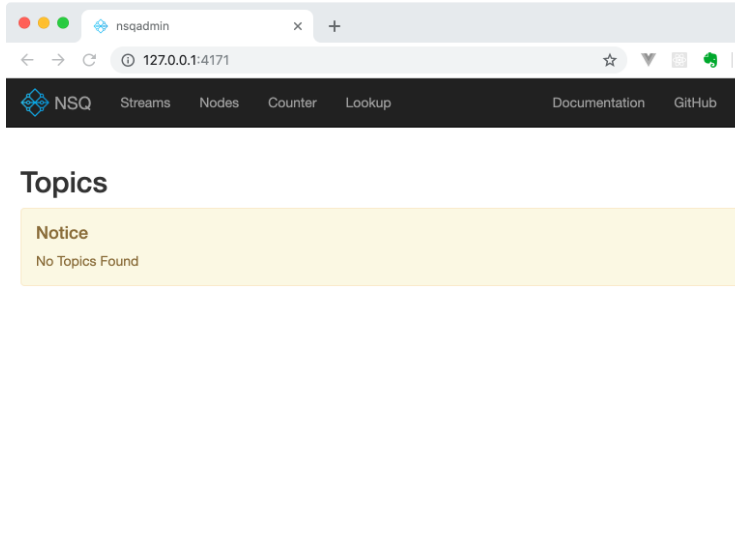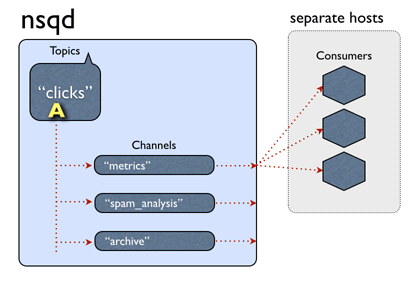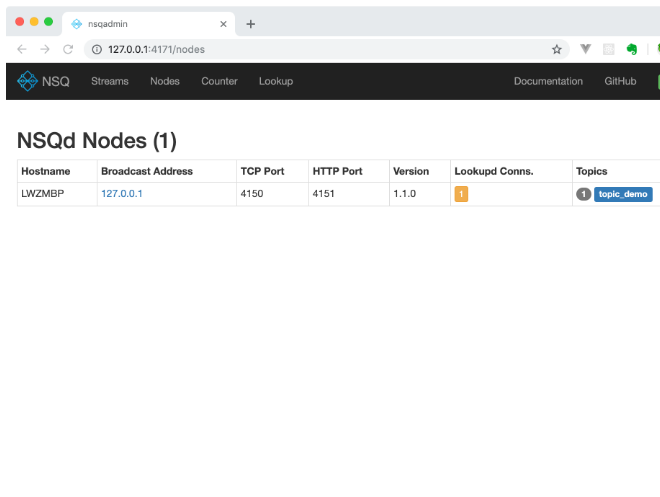GO学习-(27) Go语言操作NSQ
Go语言操作NSQ
NSQ是目前比较流行的一个分布式的消息队列,本文主要介绍了NSQ及Go语言如何操作NSQ。
NSQ
NSQ介绍
NSQ是Go语言编写的一个开源的实时分布式内存消息队列,其性能十分优异。 NSQ的优势有以下优势:
- NSQ提倡分布式和分散的拓扑,没有单点故障,支持容错和高可用性,并提供可靠的消息交付保证
- NSQ支持横向扩展,没有任何集中式代理。
- NSQ易于配置和部署,并且内置了管理界面。
NSQ的应用场景
通常来说,消息队列都适用以下场景。
异步处理
参照下图利用消息队列把业务流程中的非关键流程异步化,从而显著降低业务请求的响应时间。

应用解耦
通过使用消息队列将不同的业务逻辑解耦,降低系统间的耦合,提高系统的健壮性。后续有其他业务要使用订单数据可直接订阅消息队列,提高系统的灵活性。

流量削峰
类似秒杀(大秒)等场景下,某一时间可能会产生大量的请求,使用消息队列能够为后端处理请求提供一定的缓冲区,保证后端服务的稳定性。

安装
官方下载页面根据自己的平台下载并解压即可。
NSQ组件
nsqd
nsqd是一个守护进程,它接收、排队并向客户端发送消息。
启动nsqd,指定-broadcast-address=127.0.0.1来配置广播地址
./nsqd -broadcast-address=127.0.0.1
如果是在搭配nsqlookupd使用的模式下需要还指定nsqlookupd地址:
./nsqd -broadcast-address=127.0.0.1 -lookupd-tcp-address=127.0.0.1:4160
如果是部署了多个nsqlookupd节点的集群,那还可以指定多个-lookupd-tcp-address。
nsqdq相关配置项如下:
-auth-http-address value
<addr>:<port> to query auth server (may be given multiple times)
-broadcast-address string
address that will be registered with lookupd (defaults to the OS hostname) (default "PROSNAKES.local")
-config string
path to config file
-data-path string
path to store disk-backed messages
-deflate
enable deflate feature negotiation (client compression) (default true)
-e2e-processing-latency-percentile value
message processing time percentiles (as float (0, 1.0]) to track (can be specified multiple times or comma separated '1.0,0.99,0.95', default none)
-e2e-processing-latency-window-time duration
calculate end to end latency quantiles for this duration of time (ie: 60s would only show quantile calculations from the past 60 seconds) (default 10m0s)
-http-address string
<addr>:<port> to listen on for HTTP clients (default "0.0.0.0:4151")
-http-client-connect-timeout duration
timeout for HTTP connect (default 2s)
-http-client-request-timeout duration
timeout for HTTP request (default 5s)
-https-address string
<addr>:<port> to listen on for HTTPS clients (default "0.0.0.0:4152")
-log-prefix string
log message prefix (default "[nsqd] ")
-lookupd-tcp-address value
lookupd TCP address (may be given multiple times)
-max-body-size int
maximum size of a single command body (default 5242880)
-max-bytes-per-file int
number of bytes per diskqueue file before rolling (default 104857600)
-max-deflate-level int
max deflate compression level a client can negotiate (> values == > nsqd CPU usage) (default 6)
-max-heartbeat-interval duration
maximum client configurable duration of time between client heartbeats (default 1m0s)
-max-msg-size int
maximum size of a single message in bytes (default 1048576)
-max-msg-timeout duration
maximum duration before a message will timeout (default 15m0s)
-max-output-buffer-size int
maximum client configurable size (in bytes) for a client output buffer (default 65536)
-max-output-buffer-timeout duration
maximum client configurable duration of time between flushing to a client (default 1s)
-max-rdy-count int
maximum RDY count for a client (default 2500)
-max-req-timeout duration
maximum requeuing timeout for a message (default 1h0m0s)
-mem-queue-size int
number of messages to keep in memory (per topic/channel) (default 10000)
-msg-timeout string
duration to wait before auto-requeing a message (default "1m0s")
-node-id int
unique part for message IDs, (int) in range [0,1024) (default is hash of hostname) (default 616)
-snappy
enable snappy feature negotiation (client compression) (default true)
-statsd-address string
UDP <addr>:<port> of a statsd daemon for pushing stats
-statsd-interval string
duration between pushing to statsd (default "1m0s")
-statsd-mem-stats
toggle sending memory and GC stats to statsd (default true)
-statsd-prefix string
prefix used for keys sent to statsd (%s for host replacement) (default "nsq.%s")
-sync-every int
number of messages per diskqueue fsync (default 2500)
-sync-timeout duration
duration of time per diskqueue fsync (default 2s)
-tcp-address string
<addr>:<port> to listen on for TCP clients (default "0.0.0.0:4150")
-tls-cert string
path to certificate file
-tls-client-auth-policy string
client certificate auth policy ('require' or 'require-verify')
-tls-key string
path to key file
-tls-min-version value
minimum SSL/TLS version acceptable ('ssl3.0', 'tls1.0', 'tls1.1', or 'tls1.2') (default 769)
-tls-required
require TLS for client connections (true, false, tcp-https)
-tls-root-ca-file string
path to certificate authority file
-verbose
enable verbose logging
-version
print version string
-worker-id
do NOT use this, use --node-id
nsqlookupd
nsqlookupd是维护所有nsqd状态、提供服务发现的守护进程。它能为消费者查找特定topic下的nsqd提供了运行时的自动发现服务。 它不维持持久状态,也不需要与任何其他nsqlookupd实例协调以满足查询。因此根据你系统的冗余要求尽可能多地部署nsqlookupd节点。它们小豪的资源很少,可以与其他服务共存。我们的建议是为每个数据中心运行至少3个集群。
nsqlookupd相关配置项如下:
-broadcast-address string
address of this lookupd node, (default to the OS hostname) (default "PROSNAKES.local")
-config string
path to config file
-http-address string
<addr>:<port> to listen on for HTTP clients (default "0.0.0.0:4161")
-inactive-producer-timeout duration
duration of time a producer will remain in the active list since its last ping (default 5m0s)
-log-prefix string
log message prefix (default "[nsqlookupd] ")
-tcp-address string
<addr>:<port> to listen on for TCP clients (default "0.0.0.0:4160")
-tombstone-lifetime duration
duration of time a producer will remain tombstoned if registration remains (default 45s)
-verbose
enable verbose logging
-version
print version string
nsqadmin
一个实时监控集群状态、执行各种管理任务的Web管理平台。 启动nsqadmin,指定nsqlookupd地址:
./nsqadmin -lookupd-http-address=127.0.0.1:4161
我们可以使用浏览器打开http://127.0.0.1:4171/访问如下管理界面。

nsqadmin相关的配置项如下:
-allow-config-from-cidr string
A CIDR from which to allow HTTP requests to the /config endpoint (default "127.0.0.1/8")
-config string
path to config file
-graphite-url string
graphite HTTP address
-http-address string
<addr>:<port> to listen on for HTTP clients (default "0.0.0.0:4171")
-http-client-connect-timeout duration
timeout for HTTP connect (default 2s)
-http-client-request-timeout duration
timeout for HTTP request (default 5s)
-http-client-tls-cert string
path to certificate file for the HTTP client
-http-client-tls-insecure-skip-verify
configure the HTTP client to skip verification of TLS certificates
-http-client-tls-key string
path to key file for the HTTP client
-http-client-tls-root-ca-file string
path to CA file for the HTTP client
-log-prefix string
log message prefix (default "[nsqadmin] ")
-lookupd-http-address value
lookupd HTTP address (may be given multiple times)
-notification-http-endpoint string
HTTP endpoint (fully qualified) to which POST notifications of admin actions will be sent
-nsqd-http-address value
nsqd HTTP address (may be given multiple times)
-proxy-graphite
proxy HTTP requests to graphite
-statsd-counter-format string
The counter stats key formatting applied by the implementation of statsd. If no formatting is desired, set this to an empty string. (default "stats.counters.%s.count")
-statsd-gauge-format string
The gauge stats key formatting applied by the implementation of statsd. If no formatting is desired, set this to an empty string. (default "stats.gauges.%s")
-statsd-interval duration
time interval nsqd is configured to push to statsd (must match nsqd) (default 1m0s)
-statsd-prefix string
prefix used for keys sent to statsd (%s for host replacement, must match nsqd) (default "nsq.%s")
-version
print version string
NSQ架构
NSQ工作模式

Topic和Channel
每个nsqd实例旨在一次处理多个数据流。这些数据流称为“topics”,一个topic具有1个或多个“channels”。每个channel都会收到topic所有消息的副本,实际上下游的服务是通过对应的channel来消费topic消息。
topic和channel不是预先配置的。topic在首次使用时创建,方法是将其发布到指定topic,或者订阅指定topic上的channel。channel是通过订阅指定的channel在第一次使用时创建的。
topic和channel都相互独立地缓冲数据,防止缓慢的消费者导致其他chennel的积压(同样适用于topic级别)。
channel可以并且通常会连接多个客户端。假设所有连接的客户端都处于准备接收消息的状态,则每条消息将被传递到随机客户端。例如:
 总而言之,消息是从
总而言之,消息是从topic -> channel(每个channel接收该topic的所有消息的副本)多播的,但是从channel -> consumers均匀分布(每个消费者接收该channel的一部分消息)。
NSQ接收和发送消息流程

NSQ特性
- 消息默认不持久化,可以配置成持久化模式。nsq采用的方式时内存+硬盘的模式,当内存到达一定程度时就会将数据持久化到硬盘。
- 如果将
--mem-queue-size设置为0,所有的消息将会存储到磁盘。 - 服务器重启时也会将当时在内存中的消息持久化。
- 如果将
- 每条消息至少传递一次。
- 消息不保证有序。
Go操作NSQ
官方提供了Go语言版的客户端:go-nsq,更多客户端支持请查看CLIENT LIBRARIES。
安装
go get -u github.com/nsqio/go-nsq
生产者
一个简单的生产者示例代码如下:
// nsq_producer/main.go
package main
import (
"bufio"
"fmt"
"os"
"strings"
"github.com/nsqio/go-nsq"
)
// NSQ Producer Demo
var producer *nsq.Producer
// 初始化生产者
func initProducer(str string) (err error) {
config := nsq.NewConfig()
producer, err = nsq.NewProducer(str, config)
if err != nil {
fmt.Printf("create producer failed, err:%v\n", err)
return err
}
return nil
}
func main() {
nsqAddress := "127.0.0.1:4150"
err := initProducer(nsqAddress)
if err != nil {
fmt.Printf("init producer failed, err:%v\n", err)
return
}
reader := bufio.NewReader(os.Stdin) // 从标准输入读取
for {
data, err := reader.ReadString('\n')
if err != nil {
fmt.Printf("read string from stdin failed, err:%v\n", err)
continue
}
data = strings.TrimSpace(data)
if strings.ToUpper(data) == "Q" { // 输入Q退出
break
}
// 向 'topic_demo' publish 数据
err = producer.Publish("topic_demo", []byte(data))
if err != nil {
fmt.Printf("publish msg to nsq failed, err:%v\n", err)
continue
}
}
}
将上面的代码编译执行,然后在终端输入两条数据123和456:
$ ./nsq_producer
123
2018/10/22 18:41:20 INF 1 (127.0.0.1:4150) connecting to nsqd
456
使用浏览器打开http://127.0.0.1:4171/可以查看到类似下面的页面: 在下面这个页面能看到当前的topic信息:

点击页面上的topic_demo就能进入一个展示更多详细信息的页面,在这个页面上我们可以查看和管理topic,同时能够看到目前在LWZMBP:4151 (127.0.01:4151)这个nsqd上有2条message。又因为没有消费者接入所以暂时没有创建channel。

在/nodes这个页面我们能够很方便的查看当前接入lookupd的nsqd节点。

这个/counter页面显示了处理的消息数量,因为我们没有接入消费者,所以处理的消息数量为0。

在/lookup界面支持创建topic和channel。

消费者
一个简单的消费者示例代码如下:
// nsq_consumer/main.go
package main
import (
"fmt"
"os"
"os/signal"
"syscall"
"time"
"github.com/nsqio/go-nsq"
)
// NSQ Consumer Demo
// MyHandler 是一个消费者类型
type MyHandler struct {
Title string
}
// HandleMessage 是需要实现的处理消息的方法
func (m *MyHandler) HandleMessage(msg *nsq.Message) (err error) {
fmt.Printf("%s recv from %v, msg:%v\n", m.Title, msg.NSQDAddress, string(msg.Body))
return
}
// 初始化消费者
func initConsumer(topic string, channel string, address string) (err error) {
config := nsq.NewConfig()
config.LookupdPollInterval = 15 * time.Second
c, err := nsq.NewConsumer(topic, channel, config)
if err != nil {
fmt.Printf("create consumer failed, err:%v\n", err)
return
}
consumer := &MyHandler{
Title: "沙河1号",
}
c.AddHandler(consumer)
// if err := c.ConnectToNSQD(address); err != nil { // 直接连NSQD
if err := c.ConnectToNSQLookupd(address); err != nil { // 通过lookupd查询
return err
}
return nil
}
func main() {
err := initConsumer("topic_demo", "first", "127.0.0.1:4161")
if err != nil {
fmt.Printf("init consumer failed, err:%v\n", err)
return
}
c := make(chan os.Signal) // 定义一个信号的通道
signal.Notify(c, syscall.SIGINT) // 转发键盘中断信号到c
<-c // 阻塞
}
将上面的代码保存之后编译执行,就能够获取之前我们publish的两条消息了:
$ ./nsq_consumer
2018/10/22 18:49:06 INF 1 [topic_demo/first] querying nsqlookupd http://127.0.0.1:4161/lookup?topic=topic_demo
2018/10/22 18:49:06 INF 1 [topic_demo/first] (127.0.0.1:4150) connecting to nsqd
沙河1号 recv from 127.0.0.1:4150, msg:123
沙河1号 recv from 127.0.0.1:4150, msg:456
同时在nsqadmin的/counter页面查看到处理的数据数量为2。

关于go-nsq的更多内容请阅读go-nsq的官方文档。
GO学习-(27) Go语言操作NSQ的更多相关文章
- GO学习-(24) Go语言操作Redis
Go语言操作Redis 在项目开发中redis的使用也比较频繁,本文介绍了Go语言中go-redis库的基本使用. Redis介绍 Redis是一个开源的内存数据库,Redis提供了多种不同类型的数据 ...
- GO学习-(31) Go语言操作Elasticsearch
Elasticsearch 本文简单介绍了ES.Kibana和Go语言操作ES. Elasticsearch 介绍 Elasticsearch(ES)是一个基于Lucene构建的开源.分布式.REST ...
- GO学习-(29) Go语言操作etcd
Go语言操作etcd etcd是近几年比较火热的一个开源的.分布式的键值对数据存储系统,提供共享配置.服务的注册和发现,本文主要介绍etcd的安装和使用. etcd etcd介绍 etcd是使用Go语 ...
- GO学习-(28) Go语言操作influxDB
Go语言操作influxDB 本文介绍了influxDB时序数据库及Go语言操作influxDB. InfluxDB是一个开源分布式时序.事件和指标数据库.使用Go语言编写,无需外部依赖.其设计目标是 ...
- GO学习-(26) Go语言操作mongoDB
Go语言操作mongoDB mongoDB是目前比较流行的一个基于分布式文件存储的数据库,它是一个介于关系数据库和非关系数据库(NoSQL)之间的产品,是非关系数据库当中功能最丰富,最像关系数据库的. ...
- GO学习-(23) Go语言操作MySQL + 强大的sqlx
Go语言操作MySQL MySQL是业界常用的关系型数据库,本文介绍了Go语言如何操作MySQL数据库. Go操作MySQL 连接 Go语言中的database/sql包提供了保证SQL或类SQL数据 ...
- GO学习-(30) Go语言操作kafka
go操作kafka Kafka是一种高吞吐量的分布式发布订阅消息系统,它可以处理消费者规模的网站中的所有动作流数据,具有高性能.持久化.多副本备份.横向扩展等特点.本文介绍了如何使用Go语言发送和接收 ...
- c语言学习书籍推荐《C语言学习路线图•C语言必须知道的300个问题》下载
下载地址:点我 <C语言学习路线图•C语言必须知道的300个问题>以基础知识为框架,介绍了c语言各部分知识所对应的常见开发疑难问题,并作了透彻地解析.<C语言学习路线图•C语言必须知 ...
- 值得学习的C语言开源项目
值得学习的C语言开源项目 - 1. Webbench Webbench是一个在linux下使用的非常简单的网站压测工具.它使用fork()模拟多个客户端同时访问我们设定的URL,测试网站在压力下工 ...
随机推荐
- Java JFR 民间指南 - 事件详解 - jdk.ObjectAllocationOutsideTLAB
重新申请 TLAB 分配对象事件:jdk.ObjectAllocationOutsideTLAB 引入版本:Java 11 相关 ISSUES: JFR: RecordingStream leaks ...
- git Windows下重命名文件,大小写敏感问题
作为一个重度强迫症患者,是不忍受文件名,有字母大小拼写错误的,但是在git下,已是受控版本文件要改过来,要费些周章了. 一.环境 Widnows + git version 2.24.0 + Tort ...
- 【并发编程】ThreadLocal
ThreadLocal Thread类中 具有一个ThreadLocal.ThreadLocalMap ,这个变量是由ThreadLocal去维护的,各个线程之间相互隔离
- C/C++ 手工实现IAT导入表注入劫持
DLL注入有多种方式,今天介绍的这一种注入方式是通过修改导入表,增加一项导入DLL以及导入函数,我们知道当程序在被运行起来之前,其导入表中的导入DLL与导入函数会被递归读取加载到目标空间中,我们向导入 ...
- hdu2433 spfa+mark[x][u][v]优化
题意: 删除每一条边求最短路的和,每删除一个就输出一个和. 思路: 直接暴力可定TLE了,自己SB的尝试过,就要剪纸,当每次输出一个答案的时候我们没有必要再从 ...
- Android trap攻防思路整理
Android trap攻防 图/文 h_one 0x01 反 ...
- 基于防火墙的VRRP技术--华为防火墙双机热备--VGMP
目录 主备备份双机热备配置 负载分担双机热备配置 为了解决多个VRRP备份组状态不一致的问题,华为防火墙引入VGMP(VRRP Group Management Protocol)来实现对VRRP备份 ...
- thinkphp5.1 第三方类库引入
说明:在thinkPHP 5.1.X新版取消了Loader::import方法以及import和vendor助手函数(我的PHPExcel包在vendor文件夹中) 1.上图 2.控制器中:
- 【c#】 使用Directory.GetFiles获取局域网中任意电脑指定文件夹下的文件
本文为老魏原创,如需转载请留言 格式如下: // 获取IP地址为10.172.10.167下D盘下railway下的所有文件 string[] picArray = Directory.GetFile ...
- GDI编程基础
窗口和视口 视口是基于设备的采用的是设备坐标(单位:像素),窗口是基于程序的采用的是逻辑坐标(单位:像素/毫米/厘米等). 在默认的映射模式下,视口是与窗口等同的.但是如果改变其映射模式,则其对应的单 ...
